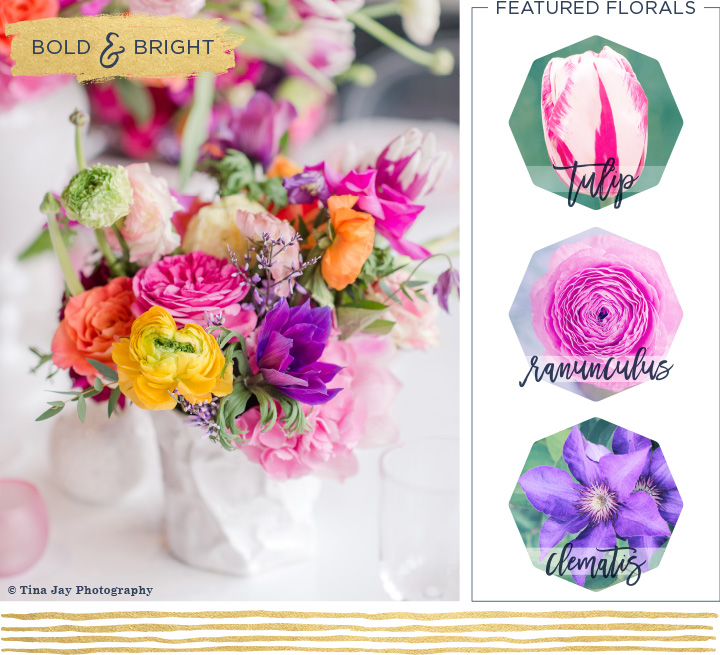Roses and peonies may be the most popular flowers for wedding centerpieces, but did you know that they pair well with exotic blooms such as protea and air plants? Whether you’re a seasoned florist, or a DIY bride, you can never run out of ideas for creative floral pairings.
That’s why FTD created these 7 wedding centerpiece ideas, that are inspired by themed color palettes. From stylish and feminine, to wild and rustic, we’ve included mood boards that feature the unique flowers that are included within each centerpiece so that you can easily recreate them. You’ll be sure to get inspired by these unique wedding centerpiece ideas and find a style that will suit the theme of your wedding!

This summer brights wedding centerpiece steals the show, adding a welcome pop of color to the white tablescape. Foster’s Flower Shop strategically incorporates pinks, oranges, yellows, greens, and purples, to beautifully showcase the colors of the season.
The centerpiece was perfectly captured by Tina Jay Photography, and is made up of hydrangea, garden roses, ginestra, anemone, ranunculus, tulips, clematis, and dahlia.
- Ranunculus – Ranunculus are popular for their bright blooms and delicate, layered petals. They do best in hardiness zones 8 to 10, and bloom in the summer. They’re great for adding texture to a bouquet or centerpiece, though they only last about a week as cut flowers.
- Tulips – Tulips are popular because of their unique shape and wide variety of colors, from bright reds and yellows to nearly black purples. They bloom from spring into early summer. Red tulips are great for weddings because they symbolize true love.
- Clematis – The Jackman clematis is the most popular type in North America. The flowers grow on a vine and bloom in mid to late summer. These purple blossoms do best in hardiness zones 4 to 8, and can grow in full sun to partial shade.
- Hydrangeas – Hydrangeas are great statement flowers because of their voluminous, round clusters of blooms. They bloom from summer into fall in shades of white, pink, purple, and blue. For some species, the color is determined by the pH of the soil.
- Garden roses – There are two types of garden roses — Modern Garden Roses and Old Garden Roses. Modern Garden Roses are the most common. They bloom continuously and have a long vase life, making them good for centerpieces.
- Ginestra – Ginestra are great accent flowers, because of their many tiny buds attached to a long stem. They are known for their strong, sweet fragrance and typically come in shades of pink, purple, yellow, and white.
- Anemone – There are many species of anemone, which are also known as windflowers. The fall blooming varieties are taller with cup-shaped blossoms, while the spring blooming varieties grow lower to the ground. They grow in a variety of colors including pink, red, purple, and white.

























